Expert’s Rating
Pros
- Stellar performance
- Superb, compact display
- Excellent cameras
- Strong battery life
Cons
- Apple Intelligence not available at launch
- Fiddly Camera Control button
- Charging still slow
Our Verdict
The iPhone 16 Pro is the best compact flagship phone you can buy, avoiding the battery life issues that affect the Pixel 9 Pro. However, the headlining AI features are disappointingly unavailable right now, and other bugbears like slow charging remain.
Price When Reviewed
This value will show the geolocated pricing text for product undefined
Best Pricing Today
Price When Reviewed
$999
Best Prices Today: Apple iPhone 16 Pro

$999.99
A lot can happen in a year. It’s a phrase we’ve heard hundreds of times, though rarely in reference to the iPhone.
Apple’s phones have matured in recent years, with the last genuine overhaul being 2017’s iPhone X. Since then, we’ve seen only incremental updates, making what was already one of the best phones just that bit better each time.
I’m not about to say that things have fundamentally changed on the iPhone 16 Pro, but there are quite a few significant improvements.
With a new A18 Pro chipset, 5x telephoto camera, bigger display, larger battery and faster MagSafe charging, it feels like a real jump compared to the iPhone 15 Pro. That’s before we even get to Apple Intelligence, though, which isn’t yet available at the time of writing.
But is the iPhone 16 Pro you buy today really worth it? Should you wait for Apple’s AI features to become established before making the jump? And is this the iPhone 16 model that’s best for most people?
I answer all these questions and more in the full review that follows.
Design & Build
- Bigger display within similar chassis
- Premium titanium and glass build
- New Camera Control button
There are some big changes on the iPhone 16 Pro, but design isn’t one of them. Its key features – glass front and back, a titanium frame, rounded corners and a flat display – are all present on the iPhone 15 Pro, though this new model has some subtle refinements.
A smaller bezel means Apple has been able to squeeze a larger display (6.3- vs 6.1-inch) within a chassis that’s only slightly taller and wider, helping the phone to remain pretty compact. It’s by no means a one-handed phone, but nothing like the huge 16 Pro Max.

Anyron Copeman / Foundry
Coming from the 6.3-inch Pixel 9 Pro, I was surprised by how similar it feels to Google’s phone. That includes the weight, which is identical at 199g. Not exactly light, but not something that ever becomes uncomfortable to hold either.
However, the iPhone 16 Pro has a few design features that you won’t find on any non-Apple phone.
The first is the Action Button, which replaced the mute switch on the iPhone 15 Pro and continues here (as well as featuring on the regular 16 models). I still mainly use it to toggle Silent Mode (via a press and hold), but it can be mapped to loads of other functions, including toggling key settings or opening your favourite app. Even more may be added once Apple Intelligence arrives.

Anyron Copeman / Foundry
The other big one is the Camera Control button. It sits recessed on the bottom-right side of the phone, and allows you to adjust a range of camera options without needing to tap on the screen.
I’ll talk about its effect on photography in the camera section, but I do find the location problematic. While in a natural position for landscape photography, it’s extremely awkward if you’re shooting in portrait for the likes of social media. Using it instead of the Action Button to quickly launch the camera app is fiddly, too.
Alongside the power button and volume controls, it means there are now five physical buttons on the sides of the iPhone 16 Pro. It’s starting to get a bit crowded.
The iPhone 16 Pro is one of the few phones I could see myself using case-free
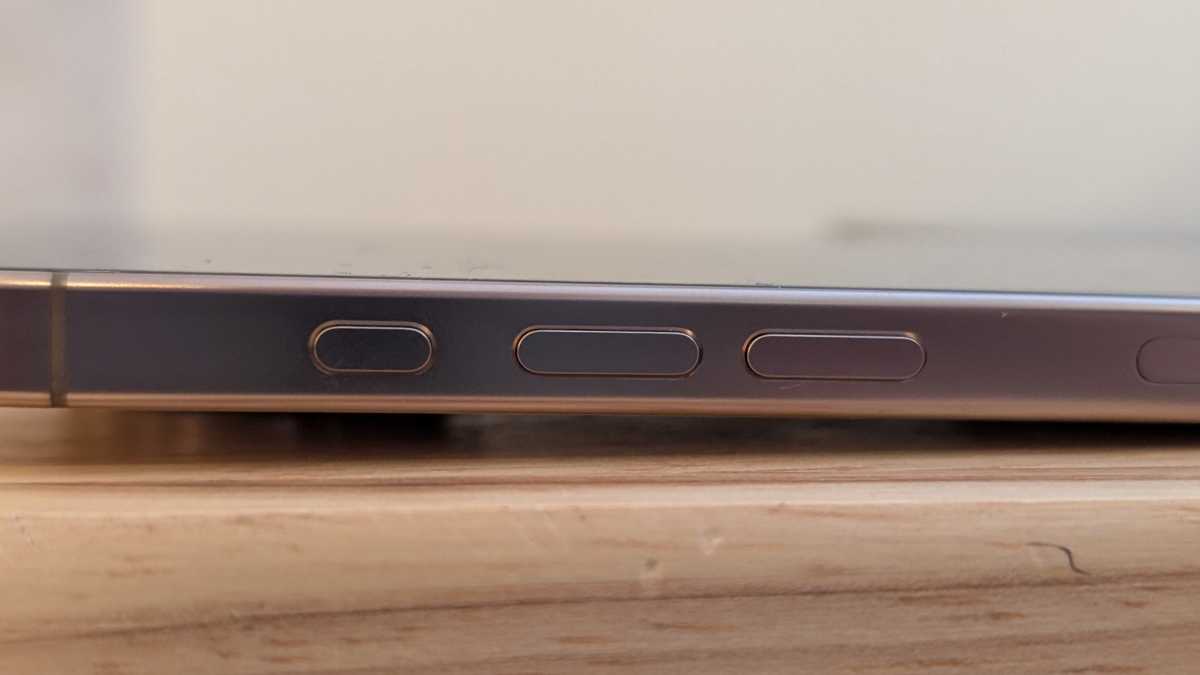
Anyron Copeman / Foundry
Sadly, the vibrant colours of the iPhone 16 and 16 Plus haven’t made it to the Pro. The golden Desert Titanium model I tested is probably the most interesting – it looks very classy in person. If that doesn’t take your fancy, Natural (silver), White and Black are also available.
However, the iPhone 16 Pro is one of the few phones I could see myself using case-free. The matt rear coating avoids visible fingerprint smudges while adding some grip. Gorilla Glass on the front and back, plus a grade 5 titanium frame, should make it resistant to most scratches and drops, though I haven’t tested this for obvious reasons.
You also get IP68 dust and water resistance, meaning it can be submerged in freshwater or surrounded by dust without any ill effects.
However, the £49/$49 official silicone case I tested alongside the phone is a great option. It offers a satisfying textured back and raised lip to protect the screen, plus the variety of colours you might’ve been craving.
Rounding off this section is a mention of the vibration motor. I’m not usually a fan of haptics and tend to turn them off on an Android phone, but I couldn’t ignore just how good they are here. The subtle, clipped feedback you get while typing, switching apps, using the Action Button and more is a real delight.
Screen & Speakers
- Larger 6.3-inch screen
- Excellent Face ID and Dynamic Island
- Impressive dual stereo speakers
As mention, the iPhone 16 Pro’s screen size has grown to 6.3-inch. That’s a change you’ll probably notice – it’s now bigger than the 6.1-inch regular iPhone 16, and in line with a key rival in the Pixel 9 Pro.
Alongside the slimmer bezel, the viewing experience is more immersive.
Just like its predecessor, the iPhone 16 Pro has one of the best displays in the business
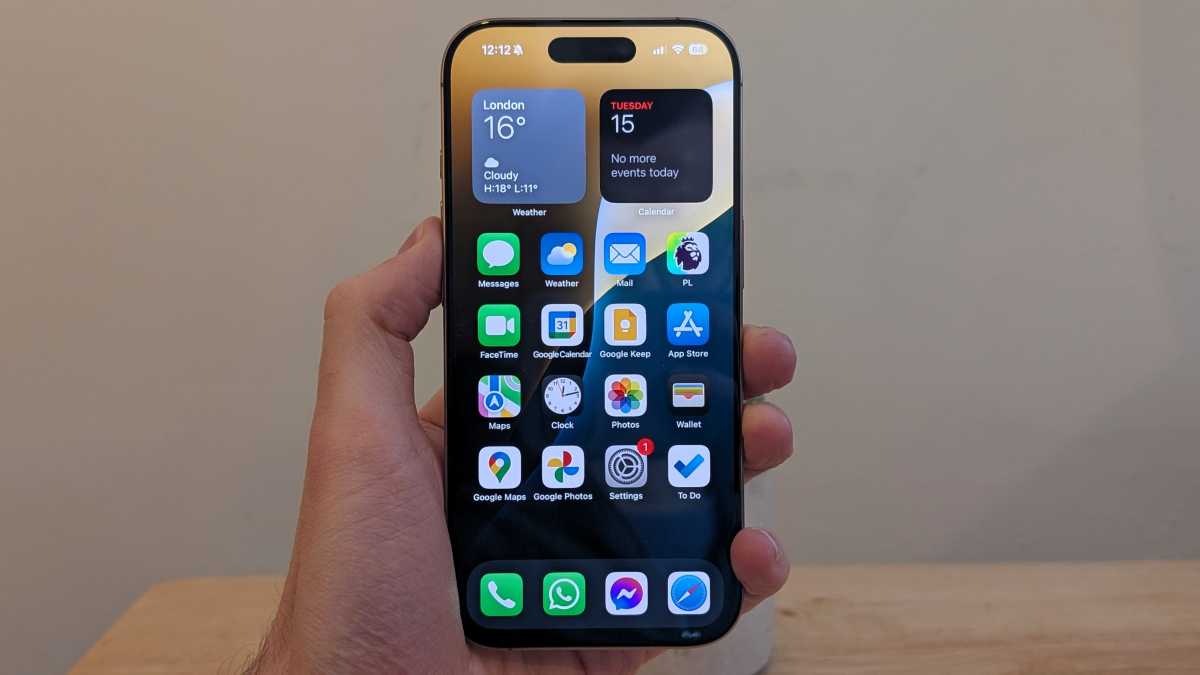
Anyron Copeman / Foundry
Elsewhere, it’s functionally identical to last year, though that’s good news. Just like its predecessor, the iPhone 16 Pro has one of the best displays in the business. It’s a rich, vibrant ‘Super Retina XDR’ OLED panel that offers stunning, vibrant colours and deep blacks.
It also gets impressively bright, offering a typical brightness of 1000 nits and peak of 2000 nits. Outdoor visibility, even in direct sunlight, isn’t a problem at all.
Apple continues to reserve the 120Hz refresh rate for Pro models, and it makes a real difference to the smoothness and fluidity of navigation and some games. LTPO tech means it can automatically drop as low as 1Hz to save battery life, which is a real plus.
The ‘Dynamic Island’ cut-out continues to be the best way to house the front facing camera and all-important Face ID sensors, which work flawlessly. Adding the ability to control media, keep track of timers and use third-party apps from there is genuinely useful.

Anyron Copeman / Foundry
I describe Face ID as “all-important” because Apple still doesn’t include a fingerprint sensor of any description on the iPhone. Unlocking and authenticating payments with my face is seamless, but there are times when I wish an under-display version of Touch ID was there too.
The iPhone 16 Pro’s stereo speakers are excellent. The sound is rich and full-bodied, getting impressively loud while maintaining clarity. If you’re in a private place (not on public transport please!), they’re a capable alternative to connecting headphones.
Specs & Performance
- A18 Pro chipset
- Superb performance
- Only 128GB storage on base model
The iPhone 16 Pro is powered by Apple’s A18 Pro chipset. This 3nm SoC has six cores – two performance and four efficiency – aiming to deliver the top-tier performance and power efficiency that modern phone users demand.
Does it succeed? If my experience is anything to go by, without a doubt. The 16 Pro excelled at everything I could throw at it, while strong battery life (more on that later) suggests efficiency is also very good.
The wide range of top-tier games on the App Store makes the iPhone 16 Pro a potent gaming device
As expected, running multiple apps simultaneously barely causes the 16 Pro to break even the slightest sweat. It feels like the phone has a heap of performance in reserve, evidenced by it never even getting slightly warm to the touch.
Even when you transition to demanding apps or AAA mobile games, everything remains smooth and lag-free. Throughout my time with the phone, there was no slowdown or lag whatsoever. And the wide range of top-tier games on the App Store makes the iPhone 16 Pro a potent gaming device.
Apple iPhone 16 Pro benchmarks
As the benchmarks below show, the A18 Pro outshines all the Android competition in CPU performance, though the limited GPU results don’t reflect the excellent performance.
Frustratingly, the base model of the iPhone 16 Pro only offers 128GB of storage. This doesn’t feel apt for a Pro phone costing this much and with no expandable storage support, I’d recommend getting at least 256GB, though 512GB and 1TB versions are also available.
Alongside Wi-Fi 7 support, you get 5G, Bluetooth 5.3 and NFC for Apple Pay, which works as advertised.
Cameras
- Upgraded 12Mp 5x telephoto lens
- Strong 48Mp main and 48Mp ultrawide
- Impressive 12Mp selfie camera
Note: Due to a technical issue, camera samples will be added soon.
Apple has made a welcome improvement to the cameras on the iPhone 16 Pro. While the telephoto lens is still 12Mp, it now supports 5x optical zoom rather than 3x, just like the 16 Pro Max.
It might not sound like a big change, but it had a significant impact on the way I took photos. Rather than trying to move closer or avoiding certain situations, I was happy to rely on the telephoto to get top-quality photos from a distance.
It’s a shame to lose the 3x optical zoom, but in my experience, the digital version is still fine here. At the other end of the scale, even photos at the maximum 25x are detailed enough to be usable.
Another benefit of the improved telephoto is its portrait abilities, though I’d recommend the default 1x or 2x instead. I was able to take some impressively professional-looking photos, and it’s fun to have a range of lighting modes to choose from. However, edge detection was lacking at times, especially on pet fur.
Crucially, the iPhone 16 Pro is very good when it comes to straight point-and-shoot photography.
In all environments, I found detail and dynamic range from the 48Mp main lens to be excellent, with stills looking impressively true to life. Phone cameras have a tendency to add lots of saturation and contrast, but Apple leaves this up to you in the edit.
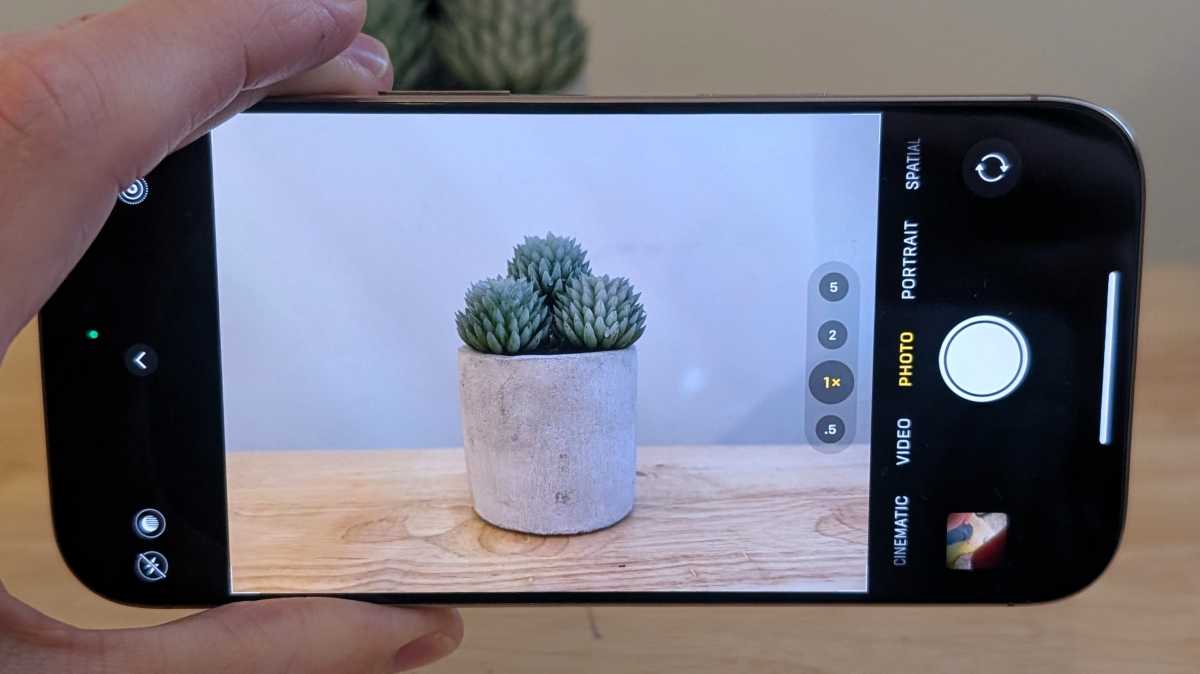
Anyron Copeman / Foundry
The 16 Pro is great in bright outdoor scenarios, but also the grey, dreary days during most of my testing. In low-light environments, the brightening effect is subtle, meaning shots stay realistic while noise is kept to a minimum.
With barely any shutter lag, I could rely on the iPhone 16 Pro’s main lens to capture meaningful moments with minimal fuss. The ‘Live Photos’ mode that’s enabled by default isn’t for everyone, though capturing the moments before and after you hit the shutter button can be useful.
For consistently great selfies, I’d choose the iPhone 16 Pro or Pro Max over any other phone
Importantly, I didn’t notice a significant drop-off in detail or overall image quality when shifting to the 48Mp ultrawide camera. The flexibility of a wider field of view is useful in a variety of scenarios, including while taking macro photos. Some of the best close-up shots I’ve ever taken on a phone have been with the iPhone 16 Pro.
On the front, a 12Mp lens is among the best around. Selfies are clear and crisp in almost all lighting conditions, while the portrait effect is fairly convincing. For consistently great selfies, I’d choose the iPhone 16 Pro or Pro Max over any other phone.
The physical Camera Control button is useful for quickly launching the camera, snapping an image or adjusting the zoom level by pressing or sliding your finger across it (even with a case on).
However, accessing exposure, depth, styles and tone modes using a light double press is fiddly, and often feels like more work than accessing them on screen. They also only really appeal to Pro photographers who want to fine-tune images.
For video, the iPhone continues to be the gold standard. The 16 Pro can shoot in up to 4K at 120fps, offering clear and smooth footage thanks to OIS (optical image stabilisation) on the main and telephoto lenses.
Alongside four studio-quality mics and various clever software features like Cinematic mode, it’s one of the very best phones for capturing video.
For video, the iPhone continues to be the gold standard
Battery Life & Charging
- 3582mAh battery (unconfirmed)
- Strong battery life
- 20W wired charging
- 25W MagSafe charging
As usual, Apple hasn’t revealed the iPhone 16 Pro’s specific battery capacity. However, GSMArena estimates it to be 3582mAh.
If you’re familiar with Android phones, that sounds very low, especially for such a power-hungry premium handset. But the combination of a power-efficient chipset and the tight integration of hardware and software means Apple can do more with less.
During my time with the iPhone 16 Pro, it offered consistently solid battery life
And so it has proved. During my time with the iPhone 16 Pro, it offered consistently solid battery life. A full charge comfortably lasted a full day in all situations, or two on the days when I was working from home.
Essentially, this is a phone where you don’t have to worry about battery life. It doesn’t quite match the excellence of the iPhone 16 Pro Max, but it’s more than good enough for the vast majority of people.
However, charging continues to be a source of frustration. Wired speeds are still limited to 20W, and only a cable is included in the box. At least USB-C is the norm now.
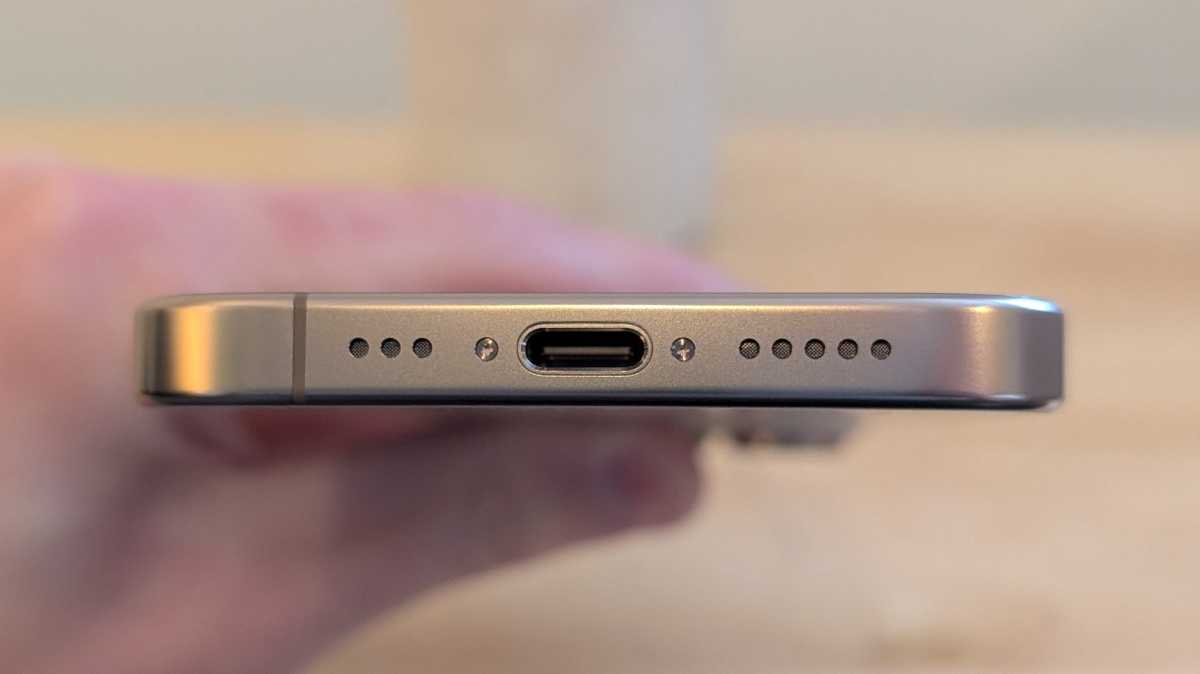
Anyron Copeman / Foundry
MagSafe charging has been upgraded to 25W, meaning it’s actually the better option if you have the right accessory. There’s also 15W regular wireless charging using the latest Qi2 standard, or 4.5W reverse wireless charging for the likes of AirPods.
Software & Apps
- iOS 18.0 at launch
- No Apple Intelligence features yet
- Likely at least seven years of updates
At launch, the iPhone 16 Pro runs iOS 18.0 out of the box. That’s significant, because the first Apple Intelligence AI features won’t be added until iOS 18.1, with a full rollout taking several months. The US is getting it in October and the UK has to wait until December.
You can download a public beta of iOS 18.1 now, which includes improvements to Siri, generative AI writing tools and notification summaries. For more on what these features are like, read our iPhone 16 Pro Max review.
However, it’s always risky to install non-final software on your main device, so I can understand if you’d rather wait. That’s what I’ve done on the iPhone 16 Pro, to give you an idea of what the software is like if you buy the phone today.
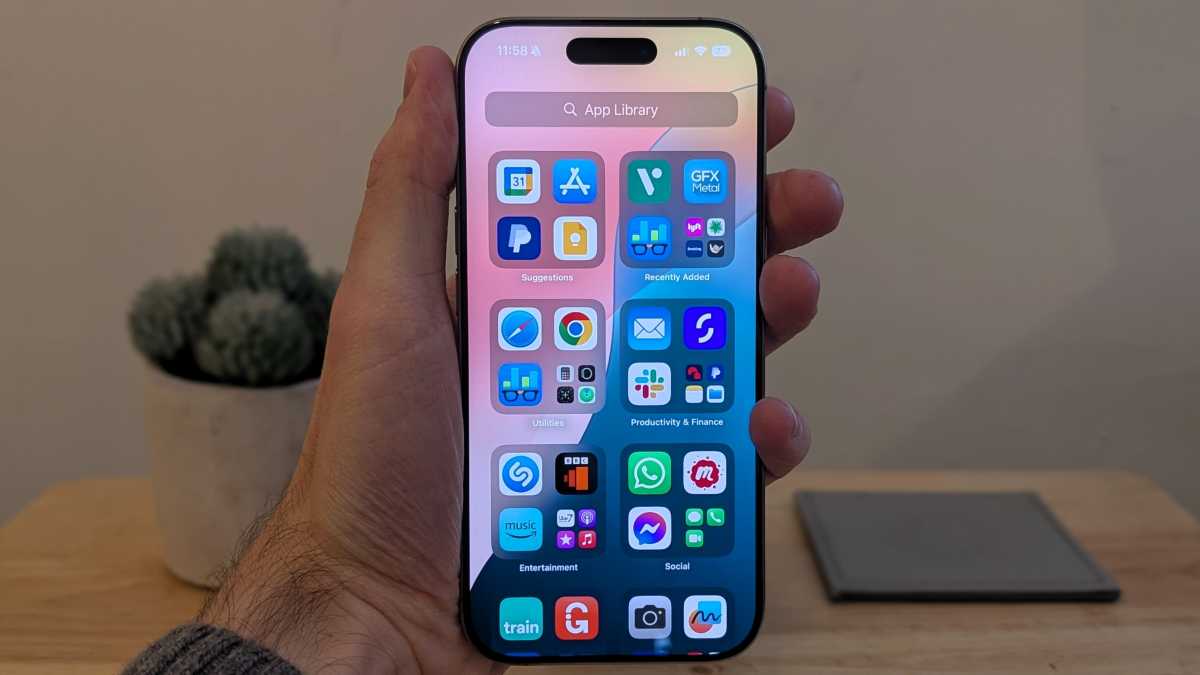
Anyron Copeman / Foundry
Essentially, if your iPhone is compatible with iOS 18, there’ll be no tangible differences from the current version of the 16 Pro.
That’s not to say there aren’t any new features, though. The new customisation options for the home screen are excellent, allowing you to fine-tune the way everything looks and lock or hide apps.
If your iPhone is compatible with iOS 18, there’ll be no tangible differences from the current version of the 16 Pro
Lock screen controls and grouped Control Center icons are nice touches, though the redesigned Photos app is confusing if you’re used to the previous version. Math Notes is a convenient way to solve equations within the Notes app, but it’s relatively niche.
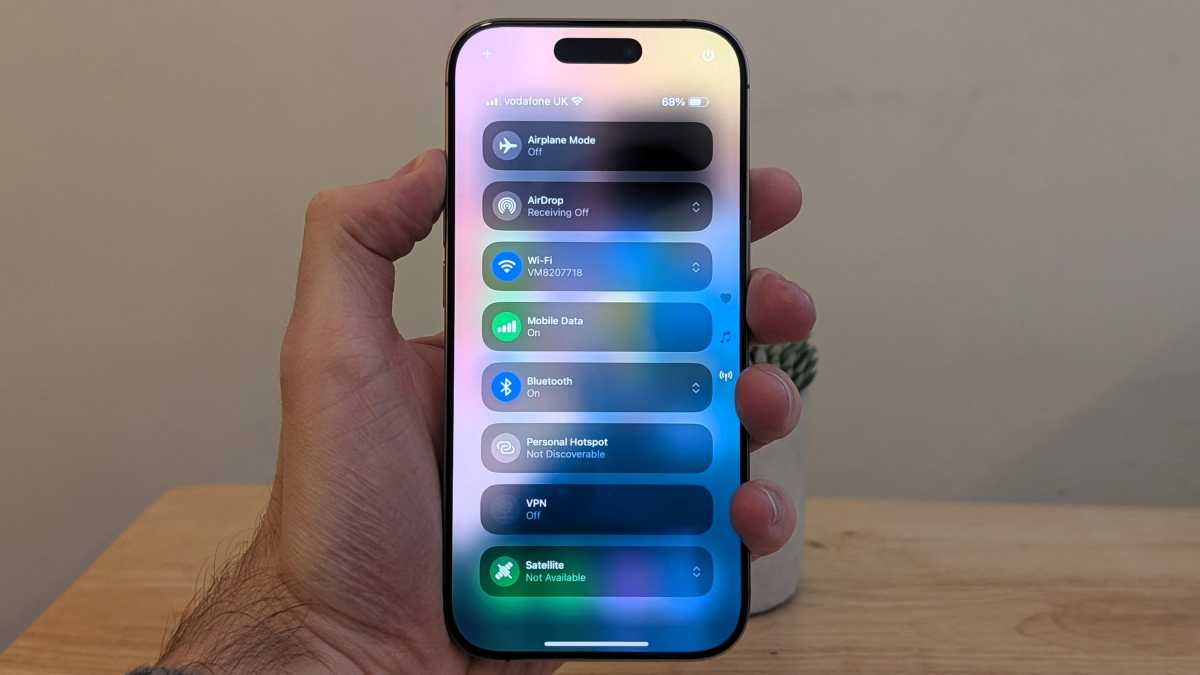
Anyron Copeman / Foundry
In its current form, iOS 18 feels a lot like iOS 17. It’s still a slick, visually appealing user interface that usually feels genuinely intuitive.
However, as someone who usually tests Android phones, I can’t get my head around the way Apple handles notifications or the general lack of multitasking features.
Software support is an area where Apple continues to excel. Assuming the iPhone 16 Pro matches what we’ve seen in the past, you can expect at least seven full years of updates.
These include regular security patches and the new major version of iOS as soon as it’s available, something many Android phones can’t match.
Price & Availability
The iPhone 16 Pro is an expensive phone.
It starts at £999/$999 for the 128GB model, though I’d recommend most people spend at least £1,099/$1,099 for 256GB. The 512GB version I tested costs £1,299/$1,299, while the top-spec 1TB model is £1,499/$1,499.
It’s available outright directly from Apple UK and Apple US, plus a range of third-party retailers and carriers. See the full selection in our guide on where to buy the iPhone 16 series.
Of course, many people will want to buy the iPhone 16 Pro on contract, which will break the cost down into more manageable payments. See the most affordable options in the UK and US below.
However, that outright price puts the iPhone 16 Pro up against some of the very best phones you can buy.
It’s cheaper than the iPhone 16 Pro Max (from £1,199/$1,199), but right in line with Android rivals such as the Samsung Galaxy S24+ (from £999/$999) and Google Pixel 9 Pro (from £999/$999).
Should you buy the iPhone 16 Pro?
If you prefer smaller phones but still want the best iPhone experience, yes. Aside from slightly worse battery life, the 16 Pro is just a more compact version of the 16 Pro Max at a more affordable price.
It means you get almost everything that makes that phone so great. Sublime A18 Pro performance, a gorgeous 120Hz display and a slick premium design. Battery life is still very solid, too.
The 16 Pro also has some of the best cameras in the business, including the 5x telephoto that was previously exclusive to the Pro Max. Even if you don’t use the hit-and-miss Camera Control button, it excels for both photos and videos.
However, it’s important to be aware that Apple Intelligence isn’t yet available at the time of writing. Without AI, especially in 2024, the iPhone 16 Pro software experience is much the same as any other phone running iOS 18.
The other frustration is charging speeds, though these are slow regardless of the iPhone you choose, and MagSafe is a convenient wireless option.
Ultimately, if you want the best iPhone experience in a more compact package, the 16 Pro is the phone for you.
Specs
- iOS 18
- 6.3-inch FHD+ 120Hz LTPO OLED
- Dynamic Island with Face ID
- Apple A18 Pro chipset
- 8GB RAM
- 128GB/256GB/512GB/1TB non-expandable storage
- 3582mAh battery (unconfirmed)
- 20W wired charging
- 25W MagSafe charging
- 25W Qi2 wireless charging
- 4.5W reverse wireless charging
- 48Mp f/1.8 main camera
- 48Mp f/2. 2 ultrawide camera
- 12Mp f/2.8 5x telephoto camera
- 12Mp f/1.9 front camera
- Dual stereo speakers
- USB-C 3.2
- 5G
- NanoSIM + eSIM
- Wi-Fi 7
- Bluetooth 5.3
- IP68
- 149.6 x 71.5 x 8.3 mm
- 199g

